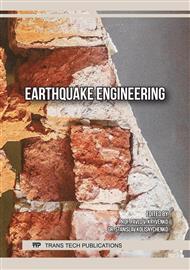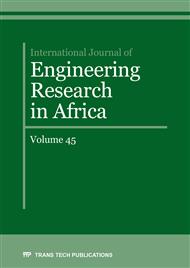[1]
J.T.P. Yao, Concept of structural control. Journal of the Structural Division, ASCE, 98(7) (1972) 1567–1574.
Google Scholar
[2]
J.P. Den Hartog, Mechanical vibrations, McGraw-Hill Book Company, New York, USA, (1947).
Google Scholar
[3]
C.R. Fuller, S. J. Nelson, P. A. Nelson, Active Control of Vibration, Academia Press Limited, 24-28 Oval Road, London, (1997).
Google Scholar
[4]
J.J. Connor, Introduction to Structural Motion Control, Prentice Hall Pearson Education, Incorporated, New Jersey, USA, (2003).
Google Scholar
[5]
P. Tan, Y. Lui, F.L. Zhou, J. Teng, Hybrid Mass Dampers for Canton Tower. CTBUH Journal, (2012) (I).
Google Scholar
[6]
M.S. Miah, E.N. Chatzi, F. Weber, Semi-active control for vibration mitigation of structural systems incorporating uncertainties. Smart Materials and Structures, 24(5) (2015) 55016.
DOI: 10.1088/0964-1726/24/5/055016
Google Scholar
[7]
X.D. Feng, M.S. Miah, Y. Ou, S.H. Guo, Dynamic response and vibration control of tensegrity systems under seismic excitation. Proceedings of the Sixth International Conference on Structural Engineering, Mechanics and Computation - SEMC 2016, Cape town, South Africa, ISBN 978-1-138-02927-9 (2016) 93-98.
DOI: 10.1201/9781315641645-16
Google Scholar
[8]
M.A. Hossain, Vibration mitigation and control of structures via a newly developed tuned mass damper. Department of Civil Engineering, University of Asia Pacific, Dhaka, Bangladesh, (2017).
Google Scholar
[9]
G. Bekdaş, S.M. Nigdeli, Mass ratio factor for optimum tuned mass damper strategies. International Journal of Mechanical Sciences, 71 (2013) 68–84.
DOI: 10.1016/j.ijmecsci.2013.03.014
Google Scholar
[10]
M.S. Miah, Dynamic Behavior of Bridge with New Innovative Type Spherical Elastomeric Bearing. Kunsan National University, Kunsan, South Korea, (2011).
Google Scholar
[11]
K.T. Jouneghani, M. Hosseini, Dynamic behavior of steel frames with tuned mass dampers, Advances in Science and Technology-Research Journal, 11(2), (2017) 146–158.
DOI: 10.12913/22998624/70763
Google Scholar
[12]
S. Elias, V. Matsagar, Research developments in vibration control of structures using passive tuned mass dampers. Annual Reviews in Control, (2017) 1–28.
DOI: 10.1016/j.arcontrol.2017.09.015
Google Scholar
[13]
Y.H. Chen, Y.H. Huang, Timoshenko beam with tuned mass dampers and its design curves. Journal of Sound and Vibration, 278(4-5) (2004) 873-888.
DOI: 10.1016/j.jsv.2003.10.013
Google Scholar
[14]
J. Mondal, H. Nimmala, S. Abdulla, and R. Tafreshi, Tuned Liquid Damper. Proceedings of the 3rd International Conference on Mechanical Engineering and Mechatronics, (68) (2014) 1–7.
Google Scholar
[15]
Q. Wu, X. Zhao, R. Zheng, Experimental Study on a Tuned-Mass Damper of Offshore for Vibration Reduction. Journal of Physics: Conference Series, 744(1) (2016) 012045.
DOI: 10.1088/1742-6596/744/1/012045
Google Scholar
[16]
H. Frahm, Device for Damping Vibrations of Bodies. U. S. Patent 989958 A, (1909).
Google Scholar
[17]
J. Ormondroyd, J.P. Den Hartog, Theory of the dynamic vibration absorber. Transactions of the American Society of Mechanical Engineers, 50 (1928) 9–22.
Google Scholar
[18]
L. Kourakis, Structural Systems and Tuned Mass Dampers of Super-Tall Buildings: Case Study of Taipei 101. M. Eng. Thesis, Dept. of Civil and Environmental Engineering, Massachusetts Institute of Technology, Massachusetts, USA, (2007).
Google Scholar
[19]
A.J. Clark, Multiple passive TMDs for reducing earthquake induced building motion. Proceedings of ninth world conference on Earthquake Engineering Tokyo Kyoto Japan, (1988) 5.
Google Scholar
[20]
S.E. Randall, D.M. Halsted, D.L. Taylor, Optimum vibration absorbers for linear damped systems. J. Mech. Des. ASME, 103, (1981) 908-913.
DOI: 10.1115/1.3255005
Google Scholar
[21]
G.B. Warburton, Optimum absorber parameters for minimizing vibration response. Earthquake Engineering and Structural Dynamics, 9 (1981) 251–262.
DOI: 10.1002/eqe.4290090306
Google Scholar
[22]
G.B. Warburton, Optimal absorber parameters for various combinations response and excitation parameters. Earthquake Engineering and Structural Dynamics, 10 (1982) 381-401.
DOI: 10.1002/eqe.4290100304
Google Scholar
[23]
G.B. Warburton, E.O. Ayorinde, Optimum absorber parameters for simple systems. Earthquake Engineering and Structural Dynamics, 8 (1980) 197-217.
DOI: 10.1002/eqe.4290080302
Google Scholar
[24]
R.J. McNamara, Tuned mass dampers for buildings. Journal of Structural Division, ASCE, 103(9) (1977) 1785-1789.
DOI: 10.1061/jsdeag.0004721
Google Scholar
[25]
M. Setareh, R.D. Hanson, Tuned Mass Dampers for Balcony Vibration Control. Journal of Structural Engineering, 118(3) (1992) 723–740.
DOI: 10.1061/(asce)0733-9445(1992)118:3(723)
Google Scholar
[27]
A.M. Kaynia, D. Veneziano, J.M. Biggs, Seismic effectiveness of tuned mass dampers. Journal of Structural Division, ASCE, 107(8) (1981) 1465-1484.
DOI: 10.1061/jsdeag.0005760
Google Scholar
[28]
P.H. Wirsching, G.W. Campbell, Minimal structural response under random excitation using the vibration absorber. Earthquake Engineering and Structural Dynamics, 2 (1974) 303-312.
DOI: 10.1002/eqe.4290020402
Google Scholar
[29]
K.S. Jagadish, B.K.R. Prasad, P.V. Rao, The inelastic vibration absorber subjected to earthquake ground motions. Earthquake Engineering and Structural Dynamics, 7 (1979) 317–326.
DOI: 10.1002/eqe.4290070403
Google Scholar
[30]
T. Pinkaew, P. Lukkunaprasit, P. Chatupote, Seismic effectiveness of tuned mass dampers for damage reduction of structures. Engineering Structures, 25(1) (2003) 39–46.
DOI: 10.1016/s0141-0296(02)00115-3
Google Scholar
[31]
N. Hoang, Y. Fujino, P. Warnitchai, Optimal tuned mass damper for seismic applications and practical design formulas. Engineering Structures, 30(3) (2008) 707-715.
DOI: 10.1016/j.engstruct.2007.05.007
Google Scholar
[32]
Y. Arfiadi, Reducing Response of Structures by Using Optimum Composite Tuned Mass Dampers. Procedia Engineering, 161 (2016) 67–72.
DOI: 10.1016/j.proeng.2016.08.499
Google Scholar
[33]
A.Y.T. Leung, H. Zhang, Particle swarm optimization of tuned mass dampers. Engineering Structures, 31(3) (2009) 715-728.
DOI: 10.1016/j.engstruct.2008.11.017
Google Scholar
[34]
P. Brzeski, T. Kapitaniak, P. Perlikowski, Novel type of tuned mass damper with inerter which enables changes of inertance. Journal of Sound and Vibration, 349 (2015) 56–66.
DOI: 10.1016/j.jsv.2015.03.035
Google Scholar
[35]
P. Cristian, S.G. Luca, F.P. Crainiceanu, I.O. Toma, G. Taranu, Design criteria of tuned mass damper systems to control vibrations of building structures. 5th International Conference on Advanced Materials and Systems, Bucharest, Romania (2014) 1-6.
Google Scholar
[36]
M.G. Soto, Tuned Mass Dampers. Archives of Computational Methods in Engineering, 20 (2013) 419–431.
DOI: 10.1007/s11831-013-9091-7
Google Scholar
[37]
M. De Angelis, S. Perno, A. Reggio, Dynamic response and optimal design of structure with large mass ratio TMD. Earthquake Engineering and Structural Dynamics, 41(1) (2012) 41–60.
DOI: 10.1002/eqe.1117
Google Scholar
[38]
C. Moutinho, An alternative methodology for designing tuned mass dampers to reduce seismic vibrations in building structures. Earthquake Engineering and Structural Dynamics, 41 (2012) 2059–(2073).
DOI: 10.1002/eqe.2174
Google Scholar
[39]
T.L. Huang and W.X. Ren, Dynamic Reliability-Based Seismic Optimal Design of Structures with Tuned Mass Damper, Advanced Materials Research, 243-249 (2011) 3770-3774.
DOI: 10.4028/www.scientific.net/amr.243-249.3770
Google Scholar
[40]
L. Qin, W.M. Yan, S.B. Guo, Numerical Study of a New Variable Friction TMD, Advanced Materials Research, 243-249 (2011) 5450-5457.
DOI: 10.4028/www.scientific.net/amr.243-249.5450
Google Scholar
[41]
H.C. Tsai, G.C. Lin, Optimum tuned-mass dampers for minimizing steady-state response of support-excited and damped systems. Earthquake Engineering and Structural Dynamics, 22 (1993) 957-973.
DOI: 10.1002/eqe.4290221104
Google Scholar
[42]
ASTM A230 / A230M-05(2011)e1, Standard Specification for Steel Wire, Oil-Tempered Carbon Valve Spring Quality, ASTM International, West Conshohocken, PA, 2011, www.astm.org.
DOI: 10.1520/a0230_a0230m-99
Google Scholar



